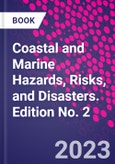This new edition includes 4 brand new chapters: Marine Debris Hazards, Coastal Wind-Blown Sand Hazards, Coastal Zone Vulnerabilities: A Social Perspective, and Coastal Zone Adaptations: Planning for the Future. There is new content assessing anthropogenic hazards such as oil spills and marine debris, and also case studies throughout the book including impacts from Hurricanes Joaquin, Hermine, Matthew, Harvey, Irma, and Maria. In the Asia-Pacific region in 2015 coastal disasters included Tropical Cyclones Komen, Pam Mar, Maysak Mar, and Typhoon Koppu.
Table of Contents
1. Perspectives on Coastal and Marine Hazards and Disasters 2. Tsunami Dynamics, Forecasting, and Mitigation 3. Paleotsunami Research Current Debate and Controversies 4. Tsunami Case Studies 5. Palaeostorm Surges and Inundations 6. Storm Surge Warning, Mitigation, and Adaptation 7. Storm Surge Case Studies 8. Sea-Level Rise: Causes, Impacts, and Scenarios for Change 9. Adapting to Sea Level Rise 10. Storm-Induced Morphology Changes along Barrier Islands and Poststorm Recovery 11. Extreme Waves: Causes, Characteristics, and Impact on Coastal Environments and Society 12. Rip Currents 13. Sea Ice: Hazards, Risks, and Implications for Disasters 14. Mangroves, Tropical Cyclones, and Coastal Hazard Risk Reduction 15. Coral Reef Systems and the Complexity of Hazards 16. Threats to Marsh Resources and Mitigation 17. Living with Harmful Algal Blooms in a Changing World: Strategies for Modeling and Mitigating Their Effects in Coastal Marine Ecosystems 18. Marine Debris Hazards 19. Coastal Wind-Blown Sand Hazards 20. A Review of Coastal Zone Vulnerabilities: A Social Perspective 21. Coastal Zone Adaptations: Planning for the Future








